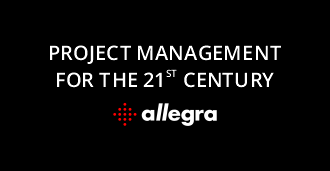Collaboration software: 6 popular tools compared
Overview
Collaboration software helps teams work together effectively, even if they are geographically dispersed. Collaboration tools must ensure that
- all stakeholders are adequately informed
- it is clear to everyone involved what is expected of them by when
- responsible persons can monitor the progress of work in real time
- the burden on resources can be objectively demonstrated
One of the most popular collaboration tools is Excel, although it was never intended and is not suitable for this purpose. There are understandable reasons for the popular management of tasks in (Excel) lists:
- all stakeholders are adequately informed
- it is clear to everyone involved what is expected of them by when
- responsible persons can monitor the progress of work in real time
- the burden on resources can be objectively demonstrated
One of the most popular collaboration tools is Excel, although it was never intended and is not suitable for this purpose. There are understandable reasons for the popular management of tasks in (Excel) lists:
- Many employees are familiar with this approach from the field of personal time and productivity management (Filofax, Time/System etc.)
- The principle is intuitive to grasp and flexible.
- It is easy to filter.
- One can quickly create simple reports.
- The tool is available to practically everyone.
- Many people know the tool from other application areas.
Why should you use a real collaboration tool for professional teamwork? Here are the key points:
- There is no version control with Excel. Often the tables are sent by e-mail and after a short time there are different, inconsistent versions. If they are stored centrally on a file server, it remains unclear who changed the files and what was changed.
- You cannot control in Excel who can see or edit what.
- In projects with several companies it is difficult to keep a central copy on a file server that is accessible to all.
- There is no support for work package structures or a work breakdown structure, only flat lists. This makes it difficult to manage large projects.
- There are no automatic change notifications. It is up to the respective processor to inform affected persons.
- There is no support for automated workflows.
Modern collaboration software such as the collaboration tools presented below are designed to overcome the shortcomings of the Excel approach. The following products achieve this to varying degrees. The order is alphabetical and does not imply any evaluation, and the selection is of course very subjective:
1. Allegra
The Allegra project management software from Steinbeis supports agile, classic and hybrid project management models fairly comprehensively. Proven methods such as the Eisenhower Principle, Earned Value, Getting Things Done and RACI Matrix are used throughout to ensure clarity even in large projects.
The Allegra project management software from Steinbeis supports agile, classic and hybrid project management models fairly comprehensively. Proven methods such as the Eisenhower Principle, Earned Value, Getting Things Done and RACI Matrix are used throughout to ensure clarity even in large projects.
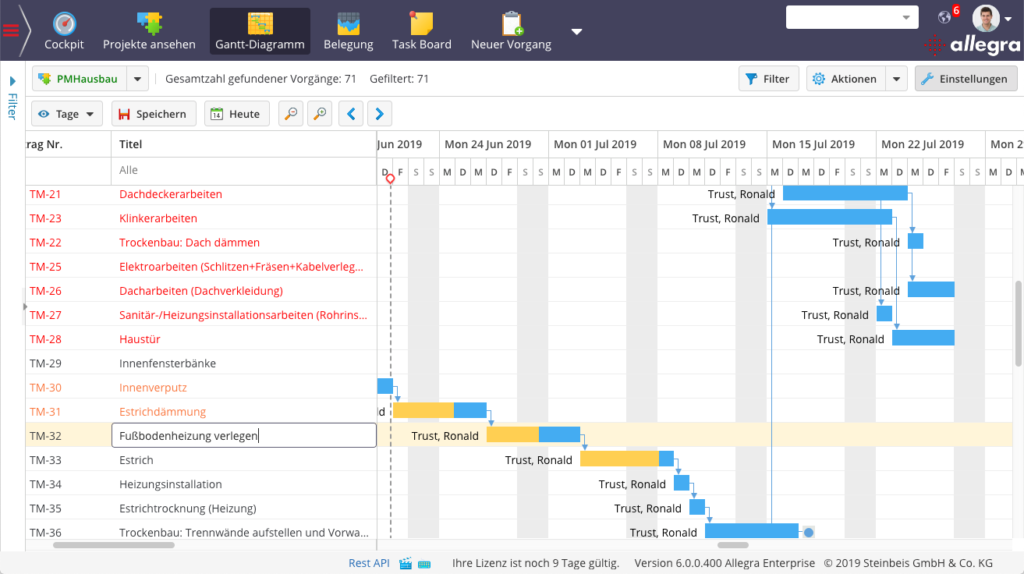
Allegra offers all the important features for collaboration software. The user interface of the collaboration tool is tidy and modern. When getting started, the configurability can be a little intimidating. But after a brief examination of the principles behind the system, you will see that everything is logical and well thought out. The Gantt chart, the resource view and the graphical workflow editor are all interactive.
Comprehensive role and authorization system
The role and authorisation system makes a well thought-out impression and is based on the RACI matrix principle. Access authorisations can be set down to individual fields. All important methods like Earned-Value, Milestone Trend, Eisenhower Principle and Getting-Things-Done are supported. Practically everywhere operations can be performed by dragging and moving (Drag & Drop).
Allegra supports all common database systems and runs on all common operating systems. It is written in Java and JavaScript, has been on the market for over ten years and is used by approximately 10,000 users.
Servers are located in Germany
Allegra Cloud is run on servers located in Frankfurt a.M., Berlin and Karlsruhe. Allegra Cloud is fully DSGVO compliant. Personal support is available via e-mail, telephone and web conferencing.
2. Asana
Asana is a widely used cloud-based collaboration tool for managing projects. An attractive user interface with many instructions and hints makes it relatively easy to get started. You cannot work productively with the free version for one user; it is merely a lure. The minimum usable user contingent serves up to 5 users and costs about 350 € per year.
Templates, lists and boards
When you create a project, you start from a project template. There are a lot of them ready and you can also create your own. In the center of the tool are projects in which tasks are managed. There is only one type of task per project, so you cannot define risks or open points, for example.
The tasks can be displayed in list views or on boards. The project management software Asana offers a timeline view similar to a Gantt chart and a calendar view. You can create your own input forms.
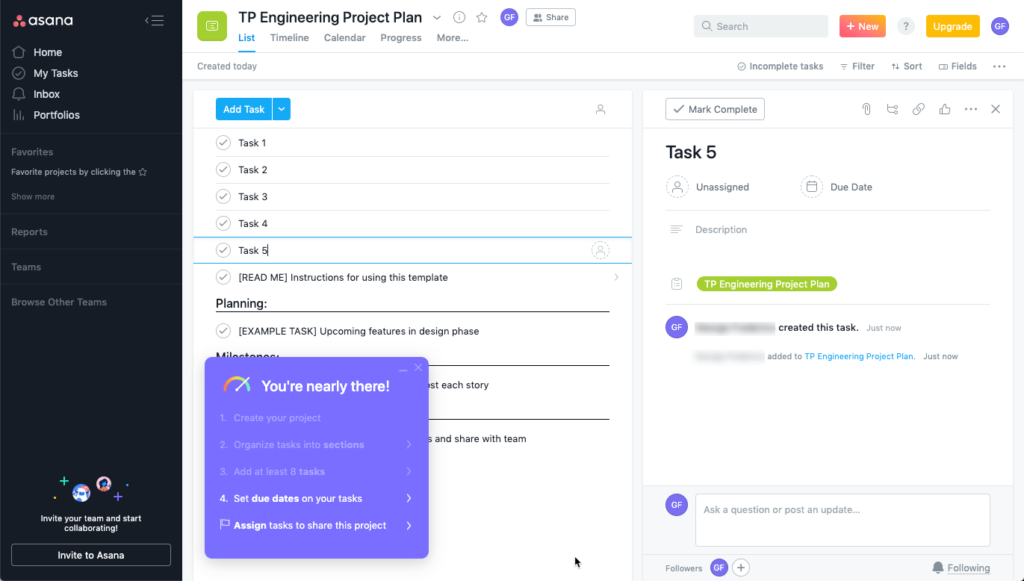
Good solution with a few gaps
It is obvious that the concept of Asana’s collaboration tool offers a completely sufficient functionality to many users. However, you should pay attention to the following points when you want to start using asana. Asana fits, if
- You do not need a Work Breakdown Structure, i.e. hierarchically arranged tasks.
- Subtasks can only be created one level deep
- You do not need sub-projects, they do not exist
- You do not need read-only and invisible task attributes
- You can treat tasks, risks, open points, milestones etc. all the same
- You do not need tables in the task descriptions
- You can do without methods like RACI or Earned Value
- You do not need a comparison between the actual state of a project and a target state
Server location in the USA
Server location in the USA and Europe
The project management software Asana runs on servers that are located in the USA and Europe. As of December 2019 Asana stated in their blog that it is possible for Enterprise customers to host their data in European data centers that are subject to the European data privacy laws.
3. Bitrix24
The Bitrix24 collaboration software supports teamwork in four categories:
- Communication
- Tasks and projects
- customer relationship management
- service desk
- website building
Behind the communication area are a chat, a video conferencing system and a shared calendar. The “Tasks and Projects” area offers functions for easy task and project management.
The strength of Bitrix24 is its CRM module, which can be seen as a serious and inexpensive alternative to SalesForce and SugarCRM. The large user community comes from this segment.
However, the range of functions in the area of “tasks and projects” cannot be compared to that of a real project management software like Allegra. Bitrix24, for example, does not know the concept of transaction types. Only tasks are managed. So you cannot distinguish between an error message, a suggestion for improvement and a project task. The system also does not offer the possibility to organize projects and tasks in hierarchical structures.
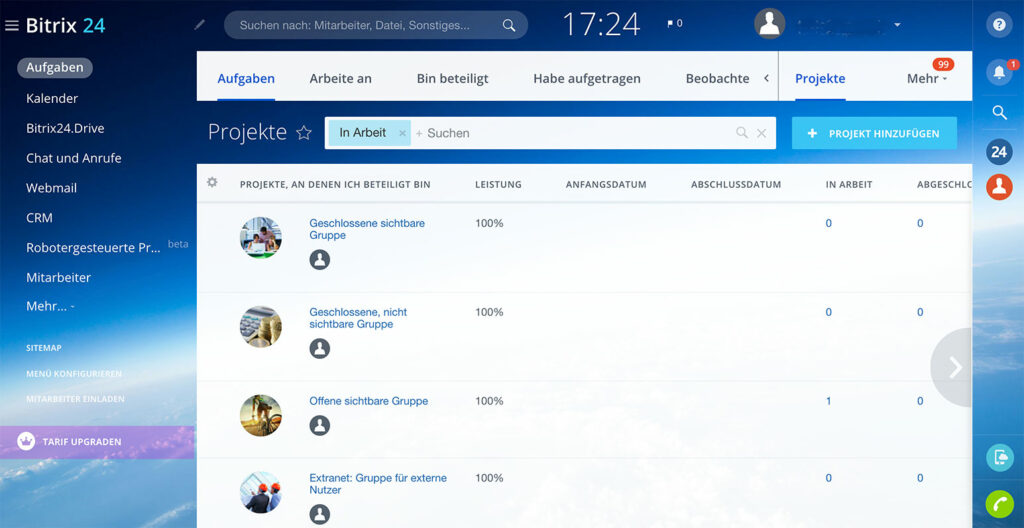
Access rights
In Bitrix24 it is not possible to define own roles with appropriate permissions. Predefined roles are available on project level and are applied to all tasks. Thus, access can be controlled at project level, but not for individual tasks within a project.
The Bitrix24 collaboration tool is offered both as a DSVGO-compliant cloud solution and as an on-premises solution. According to the manufacturer, there is a large user community.
4. Microsoft Teams
Similar to Slack, Microsoft Teams is a collaboration tool that allows you to organize your work around chat-based communication inside and outside of a company. Due to a strong integration in Office 365, teams can discuss and edit documents from other Office services and applications with colleagues.
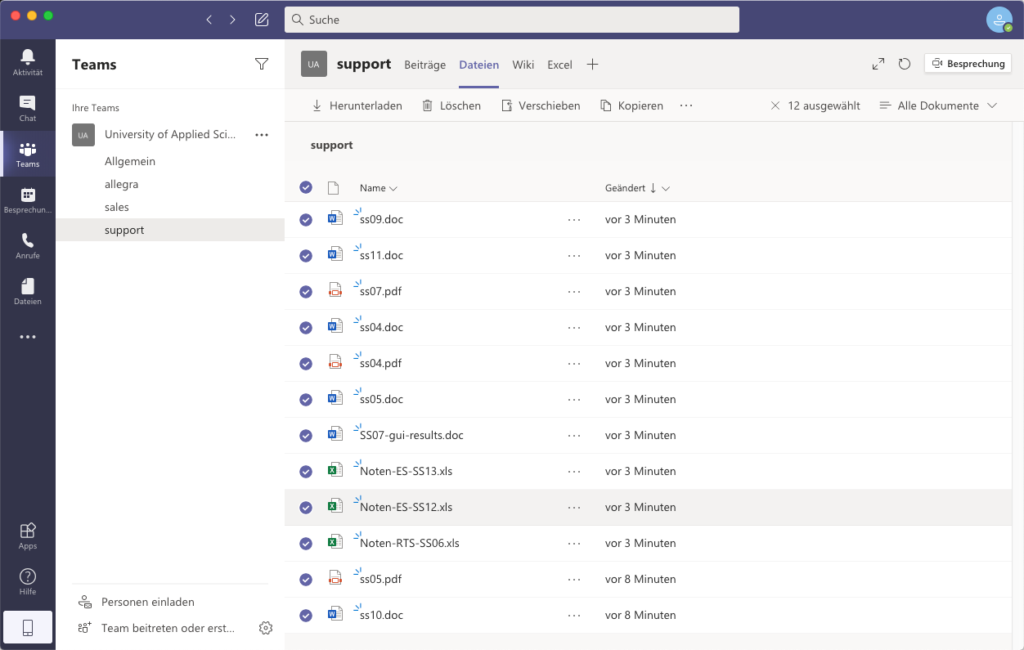
Teams can also hold online meetings, either using the video chat function or a simple telephone conference.
With WhatsApp, teams pick up the communication behaviour familiar from the private environment and translate it into the working world. As a collaboration software, it reduces the use of e-mail in particular, thus attacking one of the main productivity killers in the modern working world. The flow of communication is thus made easier, there is less disruption and disturbance. You can seamlessly switch to the more direct form of communication of a video call or a telephone conference.
So Microsoft Teams is on the one hand a very special collaboration solution, but on the other hand it is also the possible core of well organized teamwork.
5. Slack
Slack is a well done chat program in which team communication is organized in “channels”. Slack also suggests to distribute documents in the channels and sees the channel as a searchable archive. However, this overstretches the function of the collaboration tool.
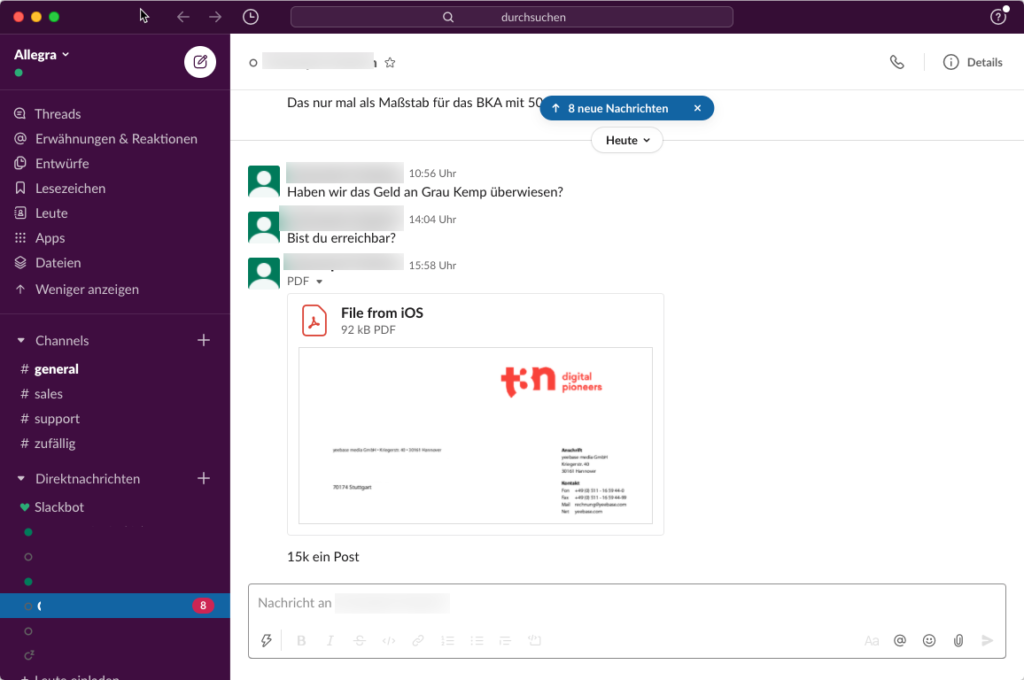
Slack remains a chat program with the strength to work more or less intensively with other collaboration tools. The Slack API is very well done. Here is a small excerpt of available integrations:
| Category | Integrations |
| Communication | GotoMeeting, Cisco Webex, Zoom, Skype, E-Mail, Outlook calendar |
| Customer support | Zendesk, Salesforce, Mail Chimp, Allegra |
| Developer tools | GitLab, GitHub, Jira Cloud, Allegra, Jenkins CI |
| File management | Dropbox, Google Drive, Microsoft OneDrive |
| Marketing | Hubspot, Clever Ads, Typeform |
| Fincance | Zoho, Teampay, Nikabot Timetracking |
| Productivity | Allegra, Asana, Trello, GitLab, GitHub, Google calendar, Outlook calendar |
| Project management | Allegra, Asana, Wrike, Jira Cloud |
| Sales | Salesforce, Zoho, Clearbit |
Slack is only offered as a cloud solution.
6. Trello
Trello is a highly configurable collaboration software for team-oriented task management. In the basic version, Trello initially offers only flat “boards” on which “lists” of tasks can be attached according to the Kanban method. With the help of so-called “power-ups” Trello can be extended considerably, so that even classic project management is possible within certain limits.
Trello only as a cloud solution
If you’re looking for collaboration software, Trello is pretty much at the top of the list in terms of features and penetration. It offers a clear, tidy and modern user interface and a wide range of functions.
Trello is offered exclusively as Software as a Service (SaaS) in the cloud operated by the manufacturer. The manufacturer guarantees compliance with the European data protection standards.
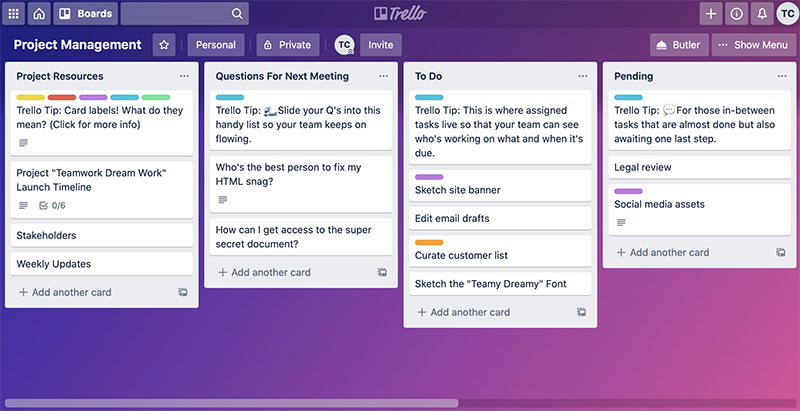
Boards instead of projects
Trello is particularly suitable for smaller projects due to the “board-with-listen” approach. The system is fully configurable. There are many so-called “power-ups” available, which can be activated board by board. There are such power-ups, e.g. with functions for hierarchical structuring, news, time recording, files, repository, forums, calendar and an interactive Gantt view.
In Trello, operations are called “cards”. These are organized in lists, which in turn belong to a “board”. There are board templates and with appropriate power-ups the cards can also be arranged hierarchically. However, there are no board types that can be used to centrally configure derived boards with their properties.
Activities and activity types
In task and project management, almost everything revolves around “processes”. In Trello, processes or cards belong to a list that can influence the behavior of corresponding processes. Lists can be created as desired, e.g. for “Tasks”, “Action items” and “Problem reports” or sorted by other characteristics.
Lists can have their own workflows and different attributes. For example, an action item has an optional deadline, whereas a start and end date must be specified for a task.
Process hierarchies
Trello offers the possibility to organize maps fully hierarchically via power-ups. The type of subordinate tasks can be restricted by so-called “rules” depending on the type of the superordinate task.
Here is a short summary of the main differentiating features of Trello compared to alternatives:
- Trello is not available as an on-premises solution, only as SaaS in the cloud of the provider
- Trello is well suited for smaller projects with a manageable number of tasks
- Trello supports only simple, non-graphical workflows
- Trello offers only limited hierarchical structuring options
Conclusion
The products presented here give a certain overview of different types of collaboration software. Allegra is a representative of a real project management software and task management software, without which effective collaboration can only be incomplete. Asana and Trello focus on simple task management, Bitrix24 on CRM and service desk, while Microsoft Teams and Slack organize collaboration around chat-based communication.

